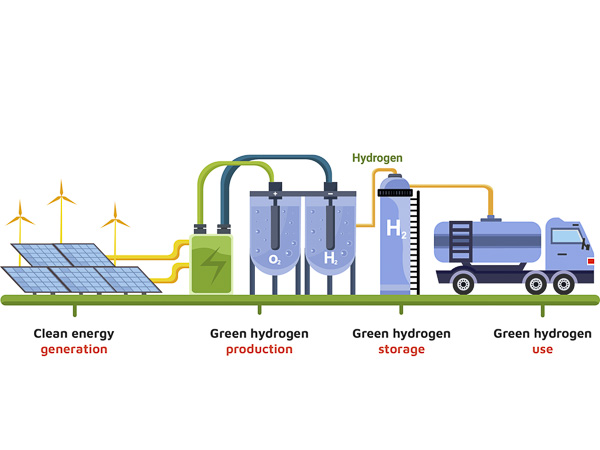How does a hydrogen electrolyzer work?
In the quest for sustainable energy solutions, hydrogen has emerged as a vital player due to its potential to provide clean energy without emitting greenhouse gases. Central to this green revolution is the hydrogen electrolyzer, a device that splits water into hydrogen and oxygen using electricity. But how does a hydrogen electrolyzer work? Let's delve into the process, efficiency, and the various methods used to produce hydrogen through electrolysis.

Two electrodes in water—one positive and one negative - release the gases during the reaction.
How Does a Hydrogen Electrolyzer Work?
Electrolysis is a process that involves an electrolytic cell composed of two electrodes (an anode and a cathode) and an electrolyte. When a direct current is applied, water molecules at the anode are oxidized to produce oxygen gas and positively charged hydrogen ions (protons). These protons move through the electrolyte to the cathode, where they combine with electrons to form hydrogen gas. This can be represented by the following reactions:
- Anode Reaction: 2H₂O → O₂ + 4H⁺ + 4e⁻
- Cathode Reaction: 4H⁺ + 4e⁻ → 2H₂
Clean Renewable Energy and Green Hydrogen Production
The true potential of hydrogen as a clean energy source is realized when clean renewable energy like solar, wind, or hydroelectric power is used to drive the electrolysis process. This method produces what is known as green hydrogen, which is entirely carbon-free.
The process begins with renewable energy being harnessed and converted into electricity. This electricity is then supplied to an electrolyzer, which uses it to split water molecules into hydrogen and oxygen. The resulting green hydrogen can be stored in tanks or underground storage facilities until it is needed.

Once produced, green hydrogen can be transported through pipelines or via specialized transport vehicles to various consumers, including industries, refueling stations for hydrogen fuel cell vehicles, and even power plants that convert hydrogen back into electricity during times of high energy demand. This cycle ensures that the energy generated from renewable sources is not wasted and can be used even when the sun isn't shining or the wind isn't blowing, providing a stable and reliable energy supply.
Types of Electrolyzers
There are three primary types of electrolyzers, each utilizing different technologies and conditions:
- Polymer Electrolyte Membrane (PEM) Electrolyzers: These electrolyzers use a solid polymer membrane as the electrolyte. They operate at relatively low temperatures (50-80°C) and offer rapid response times, making them suitable for intermittent renewable energy sources. PEM electrolyzers are compact and modular but tend to be more expensive due to the cost of the membrane material.
- Alkaline Electrolyzers: These have been in use for decades and employ a liquid alkaline solution, usually potassium hydroxide, as the electrolyte. They operate at moderate temperatures and are known for their cost-effectiveness and long commercial history. However, they are generally less efficient and slower to respond compared to PEM electrolyzers.
- Solid Oxide Electrolyzers (SOEC): These operate at high temperatures (approximately 700-800°C) and use a solid ceramic material as the electrolyte. SOEC electrolyzers offer higher efficiency by utilizing waste heat from industrial processes or concentrated solar power. They are particularly well-suited for large-scale hydrogen production.
Which Electrolysis Method is Best?
Determining which electrolysis method is best depends on various factors, including the scale of hydrogen production, the availability of heat sources, and the integration with renewable energy systems. PEM electrolyzers are ideal for applications requiring high-purity hydrogen and where renewable energy sources are variable. Alkaline electrolyzers are cost-effective for industrial applications with stable energy inputs. SOEC electrolyzers are best for large-scale operations where high-temperature heat sources are available, providing higher efficiencies and better integration with industrial processes.
Electrolyzer Efficiency
Electrolyzer efficiency is a critical factor in the overall viability of hydrogen production. It refers to the amount of electrical energy required to produce a certain amount of hydrogen. SOEC electrolyzers are typically more efficient, with efficiencies 10-26% higher than PEM and alkaline electrolyzers, due to their ability to operate at higher temperatures and utilize waste heat.
Electrolyzer and Fuel Cell: A Comparative Look
Understanding the distinction between an electrolyzer and fuel cell is essential. While an electrolyzer uses electricity to produce hydrogen, a fuel cell does the opposite by converting hydrogen into electricity through a chemical reaction with oxygen, typically for power generation in vehicles and stationary applications. The debate of fuel cell vs electrolyzer hinges on their roles in the hydrogen economy: electrolyzers are for hydrogen production, while fuel cells are for hydrogen utilization.
Summary
The role of hydrogen electrolyzers in the sustainable energy landscape cannot be overstated. They provide a pathway to produce green hydrogen, which can decarbonize various industries and offer a zero-emission alternative for transportation. As technology advances and efficiencies improve, electrolyzers will play a crucial role in the transition to a greener, more sustainable future.
Electrolyzers stand at the forefront of this hydrogen revolution, bridging the gap between renewable energy sources and practical, everyday applications of clean energy. Continued research, innovation, and investment in this field promise to unlock new potentials and drive the global transition towards a sustainable energy future.
Sources: Topsoe.com, energy.gov and chemicals.co.uk

